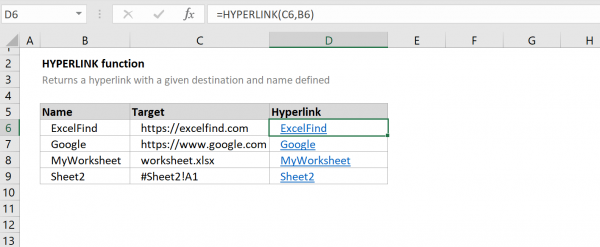Easily Insert Hyperlinks to Other Sheets in Excel

In Microsoft Excel, hyperlinks offer a seamless way to navigate between different spreadsheets or workbooks. Whether it's for organizing data, referencing other information, or enhancing the user's experience, learning how to insert hyperlinks efficiently can be a game-changer. Here's a comprehensive guide on how to master the art of hyperlinking in Excel.
Understanding Hyperlinks in Excel


Excel hyperlinks aren’t just for web pages; they can also connect cells or ranges to different sheets within the same workbook or to entirely separate workbooks. This functionality saves time by allowing quick access to related data without scrolling through various sheets manually.
How to Insert a Hyperlink

Let’s break down the steps to insert a hyperlink:
- Select the cell: Click on the cell where you want the hyperlink to appear.
- Right-click and select: Choose “Hyperlink…” from the context menu.
- Insert Hyperlink Window: A dialog box will appear. Here are your options:
- Link to an existing file or web page: Click on “File” or “Web Page” and navigate to the document or enter a URL.
- Place in this document: If you want to link to another sheet within the same workbook, select this option. Choose the sheet, then optionally, a specific cell or range.
- Create New Document: You can also create a link to a new, empty workbook.
- E-mail Address: Enter an email address to create a hyperlink that opens your default mail client with the address filled in.
- Display text: This is what users will click on. By default, it will be the URL or file path, but you can customize it for clarity.
🔗 Note: You can use keyboard shortcut Ctrl+K to quickly open the Insert Hyperlink dialog box.
Linking to Different Sheets in the Same Workbook

Linking within the same workbook is especially useful when your dataset is large or when organizing information:
- Navigate to cell: Click the cell where you want the hyperlink.
- Open the Hyperlink dialog: Use right-click or Ctrl+K.
- Select ‘Place in This Document’: Then choose the sheet to link to. If you’re linking to a specific cell, type that cell reference.
- Define text: Provide clear text that describes the destination, like “Go to Inventory Sheet” or “Summary Table”.
Here’s an example of how your dialog box might look:
| Text to display | Address |
|---|---|
| Go to Sales Data | Sheet2!A1 |

Advanced Hyperlinking Techniques

Let’s explore some advanced ways to enhance your hyperlinking skills:
Dynamic Hyperlinks

Dynamic hyperlinks change based on the value of another cell, offering an interactive experience. You can use formulas like:
=HYPERLINK(“Sheet” & A1 & “!A1”, “Link to Sheet ” & A1)
Here, if cell A1 contains “2”, the hyperlink will take you to Sheet2!A1.
Hyperlinking to Cells Based on Criteria

You can automate the hyperlinking process based on specific criteria using Excel’s lookup functions, such as VLOOKUP or INDEX/MATCH:
=HYPERLINK(“Sheet” & VLOOKUP(A2,Sheet1!A:B,2,FALSE) & “!A1”, “Link to Client Sheet ” & A2)
This formula links to different sheets based on the value in A2.
Using Macros for Hyperlinks

If you’re comfortable with VBA (Visual Basic for Applications), you can create macros to generate hyperlinks:
- Go to Developer Tab > Visual Basic.
- Insert > Module.
- Write a macro like:
Sub AddHyperlinks() Dim i As Integer, ws As Worksheet, Source As Worksheet Set Source = ThisWorkbook.Sheets(“Data”) For i = 1 To 10 Source.Hyperlinks.Add Anchor:=Source.Cells(i, 1), Address:=“”, SubAddress:=“Sheet” & i & “!A1”, TextToDisplay:=“Go to Sheet ” & i Next i End Sub - Run the macro to create hyperlinks dynamically.
By mastering these techniques, you'll not only improve the functionality of your Excel workbooks but also make them more user-friendly and efficient.
Recap

The ability to insert hyperlinks in Excel is not just about convenience; it’s about enhancing the navigational experience, increasing productivity, and making complex data management easier. From basic hyperlinking to dynamic links, macro-driven solutions, and more, Excel provides numerous ways to connect and navigate data. With this guide, you’re equipped to leverage hyperlinks to make your Excel experience smoother and more intuitive.
How do I remove a hyperlink in Excel?

+
To remove a hyperlink, right-click on the cell containing the link and select “Remove Hyperlink”.
Can I edit a hyperlink after inserting it?

+
Yes, you can. Right-click on the cell with the hyperlink, select “Edit Hyperlink”, and modify the link as needed.
What are the benefits of using hyperlinks in Excel?

+
Hyperlinks streamline navigation, enhance usability, organize data efficiently, and allow for dynamic, automated user interactions.